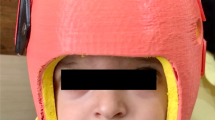Abstract
Background
A total of 100 patients who presented with synostosis of the metopic or coronal suture were consecutively treated during a 6-year period using minimally invasive endoscopic-assisted suturectomies. After surgery, all patients were fitted with custom-made cranial helmets for up to 12 months.
Materials and methods
The coronal group consisted of 50 patients, 26 females and 23 males with a mean age of 3.78 months. Surgery was done through a single 2-mm incision at the ipsilateral stephanion. After endoscopic-assisted dissection, a craniectomy of the involved suture was done (mean width, 6 mm, and mean length, 10 cm). The metopic group consisted of 50 patients, 35 males and 16 females with a mean age of 4.1 months. A single 2- to 3-cm incision was placed on the midline behind the hairline. A suturectomy of the suture from anterior fontanelle to nasofrontal suture was performed (mean width, 7 mm, and mean length, 9.8 cm).
Results
For the entire cohort, the mean estimated blood loss was 34 cc (5–250 cc). The mean estimated percent of blood volume lost was 5.2% (1–26%). There were no intraoperative blood transfusions and five postoperative for a total transfusion rate of 6.7%. The mean surgical time was 56 min. All but one patient (99%) was discharged on the first postoperative day. Complications included two dural tears and four pseudomeningoceles. There were two cases of incomplete reossification of the craniectomy. There were no infections, mortalities, hematomas, or visual injuries. There were no complications related to helmet therapy except three superficial skin breakdowns that cleared immediately with helmet non-use for 3–4 days. Using anthropometric measurements and extensive photographic and physical assessments, excellent results were obtained in 84%, good results in 9%, and poor results in 7% of patients.
Conclusions
Early treatment of infants with coronal or metopic craniosynostosis using endoscopic assisted minimally invasive suturectomies is a safe and efficacious treatment alternative associated with excellent results in a large portion of these patients.














Similar content being viewed by others
References
Cohen M (2205) Editorial: perspectives on craniosynostosis. Am J Med Genetics 136A:313–326
MacGregor FA (1990) Facial disfigurement: problems and management of social interaction and implications for mental health. Aesthet Plast Surg 14:249
Lane LC (1892) Pioneer craniectomy for relief of mental imbecility due to premature sutural closure and microcephales. JAMA 18:49
Anderson FM, Johnson FC (1956) Craniosynostosis: a modification and surgical treatment. Surgery 40:661–970
Faber HK, Towne EB (1927) Early craniectomy as a preventive measure in oxycephaly and allied conditions with special reference to the prevention of blindness. Am J Med Sci 173:701–711
Hoffman HJ, Mohr G (1976) Lateral canthal advancement of the superorbital margin. J Neurosurg 45:376–381
Persing JA, Jane JA, Park TS, Edgerton MT, Delashaw JB, Floating C (1990) Shaped orbital osteotomy for orbital rim advancement in craniosynostosis: preliminary report. J Neurosurg 72:22
Cohen SR, Kawamotto HJ Sr, Burstein F, Peacock WJ (1191) Advancement-onlay: an improved technique of fronto-orbital remodeling in craniosynostosis. Child’s Nerv Syst 7:264
Elisevich K, Bite V, Colcleugh RG (1991) Orbital rim and molar advancement for unilateral corornal synostosis in older pediatric age group. J Neurosurg 74:219
Jane JA, Park TS, Zide BM, Lambruschi P, Persing JA, Edgertom MT (1984) Alternative techniques in the treatment of unilateral coronal synostosis. J Neurosurg 61:550
Whitaker LA, Schut L, Kerr LP (1997) Early surgery for isolated craniofacial dysostosis. Plast Reconstr Surg 91:977
Marchac D (1978) Radical forehead remodeling for craniostenosis. Plast Reconstr Surg 61:823
Marchac D, Renier D (1981) Craniofacial surgery for craniosynostosis. Scand J Plast Reconstr Surg 15:235
Author information
Authors and Affiliations
Corresponding author
Rights and permissions
About this article
Cite this article
Jimenez, D.F., Barone, C.M. Early treatment of anterior calvarial craniosynostosis using endoscopic-assisted minimally invasive techniques. Childs Nerv Syst 23, 1411–1419 (2007). https://doi.org/10.1007/s00381-007-0467-6
Received:
Published:
Issue Date:
DOI: https://doi.org/10.1007/s00381-007-0467-6




